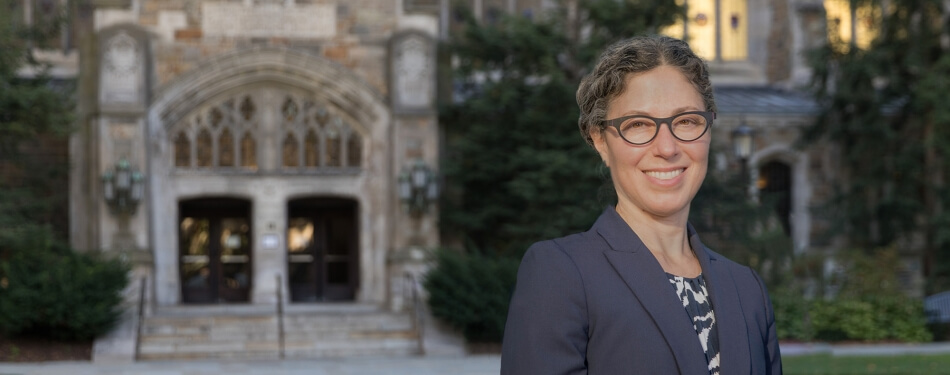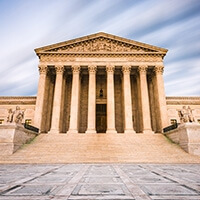Changes to the way the United States regulates energy can make the electric grid more reliable and more sustainable, according to an award-winning paper coauthored by Professor Alexandra Klass.
The paper, titled “Grid Reliability Through Clean Energy,” recommends numerous specific reforms to energy policy and governance that its authors argue will move the country toward a cleaner and more reliable electric grid. Written by Klass, along with Joshua Macey, Shelley Welton, and Hannah Wiseman, the article appeared in the Stanford Law Review in 2022.
The recommended changes are in the areas of electricity market structure; interstate electric transmission line planning, siting, and financing; grid reliability regulation; and Regional Transmission Organization (RTO) governance.
Earlier this year, the Sandra Day O’Connor College of Law at Arizona State University awarded the paper its prestigious Morrison Prize, given to the most impactful sustainability-related legal academic article published in North America during the previous year. The award praised the article’s “innovative strategies for strengthening grid reliability while accelerating the nation’s transition to a lower-carbon energy system.”
“The Morrison Prize and ASU’s annual sustainability conference have become key drivers in bringing together scholars and practitioners to tackle the important energy and sustainability challenges of our day,” Klass said. “I am delighted that our article was recognized as part of that effort.”
Klass—the James G. Degnan Professor of Law, who until recently served as the US Department of Energy’s deputy general counsel for energy efficiency and clean energy demonstrations—answered five questions about the issues addressed in the paper:
1. There seems to be a widespread belief in this country that fossil fuels are more reliable than renewables. When did you first start to question that?
My colleagues who work in this area and I have questioned that for a long time. Wind and solar energy have become much more established forms of energy generation, and are a very large percentage of what’s powering the grid in many states. People will say, well, what do you do when the wind isn’t blowing and the sun isn’t shining? Yes, that is a limitation on those resources when taken in isolation. But the electric grid is a complex, interconnected system of different energy resources dispatched at different times and under different conditions and seasons. The cost of battery storage for renewables is declining rapidly, while the cost of wind and solar energy is already cost-competitive with fossil fuel resources. Just as important, electric grid operators are increasingly able to plan around the intermittency of wind and solar energy to ensure grid reliability and can combine those resources with nuclear, hydropower, and newer forms of clean, “firm” (e.g., on-demand) energy resources to both reduce electricity costs and maintain reliability.
At the same time, forms of energy from fossil fuels have their own reliability problems. Natural gas supply lines freeze, coal piles freeze, nuclear plants are subject to routine and emergency maintenance. During the recent heat wave in Texas and in the US South, it was primarily the nuclear, coal, and gas plants that underperformed and created reliability problems, just like we saw during Winter Storm Uri in Texas and the lower Midwest states in 2021.
2. What’s stopping improvements to the system right now?
We’ve politicized the energy system and energy resources over the last 15 or 20 years in a way that creates barriers to integrating more clean energy into the electric grid and investing in needed reliability improvements. The problems aren’t technical; we know how to do this, and we can do this. And the problems are not even financial, because renewable energy is now the lowest cost form of energy, by far. Moreover, since the time we wrote this paper, Congress has enacted the Inflation Reduction Act, which includes a massive amount of long-term federal funding for all forms of carbon-free energy as well as energy storage technologies and other projects that will both decarbonize the grid and make it more reliable.
The problem we see is a governance problem in terms of how reliability versus energy resources are regulated, with regard to how the markets operate, who’s in charge of those energy markets, and how we build new long-distance electric transmission lines required for the clean energy transition and for reliability needs.
With regard to transmission lines, for example, we have a patchwork of regulatory authorities. So if you’re building a transmission line through five different states, it’s not the federal government that gives that approval. Every single state needs to grant permission and potentially grant eminent domain authority. And in some states, every county also needs to do that. And those states don’t always have the same interests. That’s made it very difficult to build the long-distance, high-voltage transmission lines that we need.
3. Considering your recommended reforms in the paper, is there one that stands out that would have the biggest impact?
My co-authors would likely give different answers, but for me, building more long-distance electric transmission lines is the key. That’s how you get more renewable energy into the grid right now and that’s how you increase reliability for all electricity resources. We’re very good now at building wind farms and solar farms. We can do those pretty quickly. But you can’t add new wind energy or new solar energy to the grid unless there’s space in those lines. So we need to build new high-voltage transmission lines to move that energy from place to place.
The Federal Energy Regulatory Commission (FERC) has longstanding authority to grant permits and eminent-domain authority for companies building interstate natural gas pipelines. Congress could grant similar authority to FERC to do the same for interstate electric transmission lines. Will that make it easy to build more transmission lines? No, because you’ll still have opposition, you’ll still have litigation, you’ll still have procedural requirements. But you only have to do it once, with one federal agency, as opposed to doing it five times with different states, which extends the process out more than a decade in most cases, and results in many needed lines not being built at all.
4. Would it help the situation if more electric utilities were fully public institutions?
Not necessarily. The way we have built our electricity system, we’ve got a lot of expertise and a lot of innovation in the private sector, both in the investor-owned utilities and the merchant energy generation companies. Renewable energy is big business now, and those companies can often move more quickly than the federal government as a whole or even states or local governments. So I don’t know that we would accelerate anything by making the whole thing public. Having said that, public ownership in parts of the system may be helpful under certain circumstances, such as creating new municipal utilities where a community is dissatisfied with its incumbent investor-owned utility. But in other situations, improved regulation of the private sector can accomplish similar goals.
5. How would your reforms advance the concept of environmental justice?
As in many areas, it’s often the most disadvantaged among us who are the most harmed when our electricity system doesn’t work. You see that in every hurricane, every heat wave, every winter storm. So the question is, how do we benefit disadvantaged communities, provide more equity in the system, and also make it more participatory? A lot of our governance problems are about consolidated power of legacy interests. And if you open up that system, you potentially can create increased benefits for disadvantaged communities.
For example,with regard to solar energy, we need to make sure it’s not just wealthy people who have access to the benefits. Requiring community solar, where you can subscribe to solar systems in a multifamily unit, is one way to do that. In addition, the Inflation Reduction Act provides enhanced resources for low-income residents to take advantage of home electrification through tax credits and subsidies for electric heat pumps and energy efficiency improvements to homes. These improvements reduce household and systemwide energy costs and improve reliability in addition to decreasing the use of fossil fuels in our energy system as a whole.







